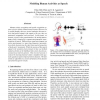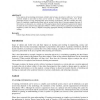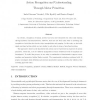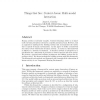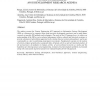CORR
2011
Springer
13 years 5 months ago
2011
Springer
Despite recent advances in uncovering the quantitative features of stationary human activity patterns, many applications, from pandemic prediction to emergency response, require a...
CVPR
2011
IEEE
13 years 9 months ago
2011
IEEE
Human activity recognition and speech recognition appear to be two loosely related research areas. However, on a careful thought, there are several analogies between activity and ...
EUSFLAT
2009
13 years 11 months ago
2009
In this paper, computer vision and fuzzy set theory are merged for the robust construction of three-dimensional objects using a small number of cameras and minimal a priori knowled...
ETS
2002
IEEE
14 years 1 months ago
2002
IEEE
In the analysis of any learning environment, whether small or large, one observes within it a "set of human activities related to each other so they can be viewed as a whole&...
CAS
2004
14 years 1 months ago
2004
Accounting for human activity through physics does not require anything more than a switch of mind. Objectivity needs first to be recognized as an epistemological principle that s...
COMPUTER
2007
14 years 1 months ago
2007
and therefore should be implemented outside the sensory-motor system. This way, meaning for a concept amounts to the content of a symbolic expression, a definition of the concept ...
AR
2007
14 years 1 months ago
2007
In robotics, recognition of human activity has been used extensively for robot task learning through imitation and demonstration. However, there has not been much work on modeling...
DAGSTUHL
2006
14 years 3 months ago
2006
Human activity is extremely complex. Current technology allows us to handcraft real-time perception systems for a specific perceptual task. However, such an approach is inadequate...
ECIS
2004
14 years 3 months ago
2004
The authors present the Context Engineering (CE) approach to Information Systems Development (ISD) as a framework to organise ideas about previous development experience and to gu...
IEEEICCI
2002
IEEE
14 years 6 months ago
2002
IEEE
In this contribution we present a theoretical approach which has been utilized to inform the coordination of the development of complex systems. Coordination is regarded as a form...

